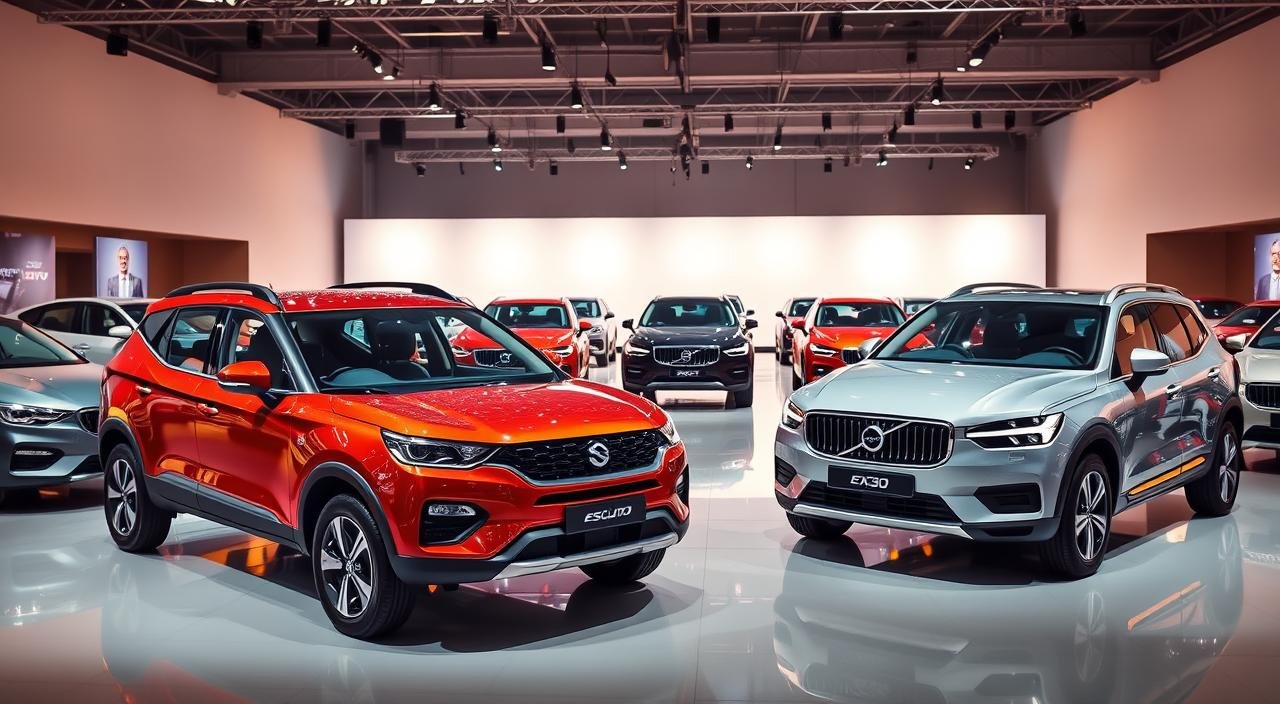
Oct
Could September 2025 be a game-changer for India’s car market? It’s set to see a flood of new car releases. These changes could alter how people choose their next vehicle.
Six big names are ready to show off their latest models in September 2025. Maruti Suzuki will kick things off with a new SUV on September 3rd. VinFast will introduce two electric cars in India on September 6th. Citroen will unveil the Basalt X on September 5th. Mahindra will update the Thar, and Volvo will launch the EX30 by the end of the month.
These new cars will cost between Rs 9.7 lakh and Rs 50 lakh. This range offers something for everyone, from budget-friendly SUVs to high-end electric vehicles. It shows how India’s car market is growing, with both traditional and electric options available.
Key Takeaways
- Six major car brands schedule launches throughout September 2025
- Price points range from Rs 9.7 lakh to Rs 50 lakh across different segments
- VinFast enters India with two electric models on September 6th
- Maruti Suzuki kicks off the month with a new SUV on September 3rd
- Electric and traditional fuel options provide diverse choices for buyers
- Mahindra Thar receives updates while maintaining its rugged appeal
- Volvo EX30 brings Swedish safety innovation to the electric segment
Overview of September 2025 Car Launches
September 2025 is a big month for the car world. Many new vehicles will be shown off, combining the latest tech with designs that people love. This month, we’ll see more electric cars, affordable luxury, and better safety features.
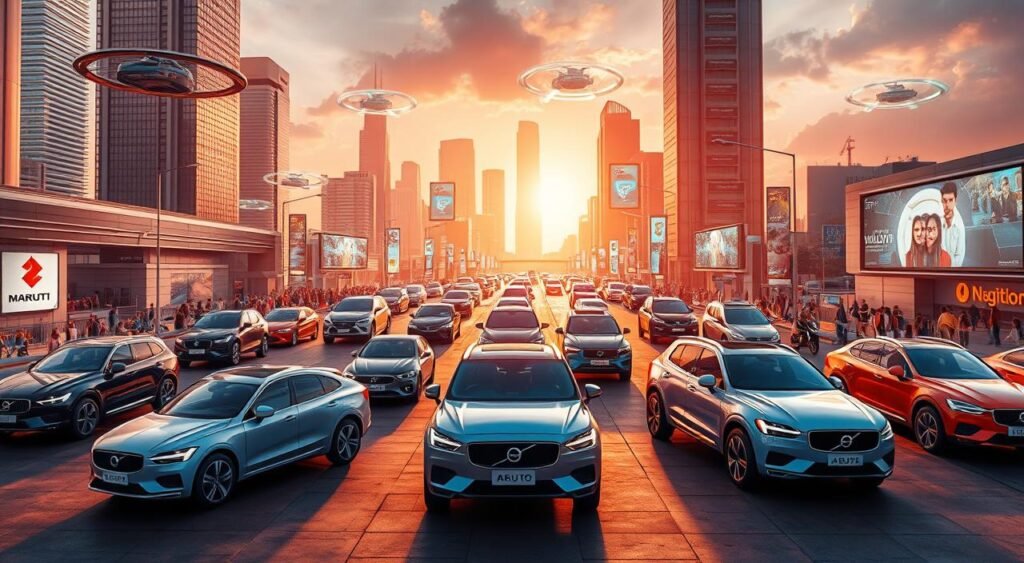
What to Expect from the Latest Models
This month, there’s something for everyone. Maruti’s new SUV is perfect for those who want something in between the Brezza and Grand Vitara. VinFast is launching two electric SUVs in Tamil Nadu. Citroen is adding a premium touch to the Basalt X with black finishes and ambient lights.
Mahindra is updating the Thar with a modern twist, keeping its rugged charm. Volvo is joining the electric compact car market with the EX30, showing their dedication to green cars.
Exciting Innovations in Design and Technology
September will bring big tech leaps in cars. Some highlights include:
- Panoramic sunroofs becoming standard in mid-segment vehicles
- Level-2 ADAS (Advanced Driver Assistance Systems) for enhanced safety
- 360-degree camera systems for improved visibility
- Larger touchscreen displays reaching up to 12.9 inches
- Wireless charging capabilities and ventilated seats
- Advanced battery technologies for up to 496 kilometers range
These new cars show how manufacturers are listening to what people want. They’re making tech-rich, eco-friendly cars that are also affordable.
Spotlight on Maruti Escudo
The Maruti Escudo is one of the most awaited cars in September 2025. It’s a big step for Maruti to enter the mid-size SUV market. Built on Suzuki’s Global C platform, it offers great value and reliability.
Key Features of the Maruti Escudo
The Maruti Escudo has features that match high-end cars. It has a long wheelbase for more space, perfect for Indian families. All models come with:
- Panoramic sunroof for an airy feel
- Ventilated front seats for comfort in hot weather
- Six airbags for safety
- 360-degree camera system for easy parking
- Advanced Driver Assistance Systems (ADAS) in higher variants
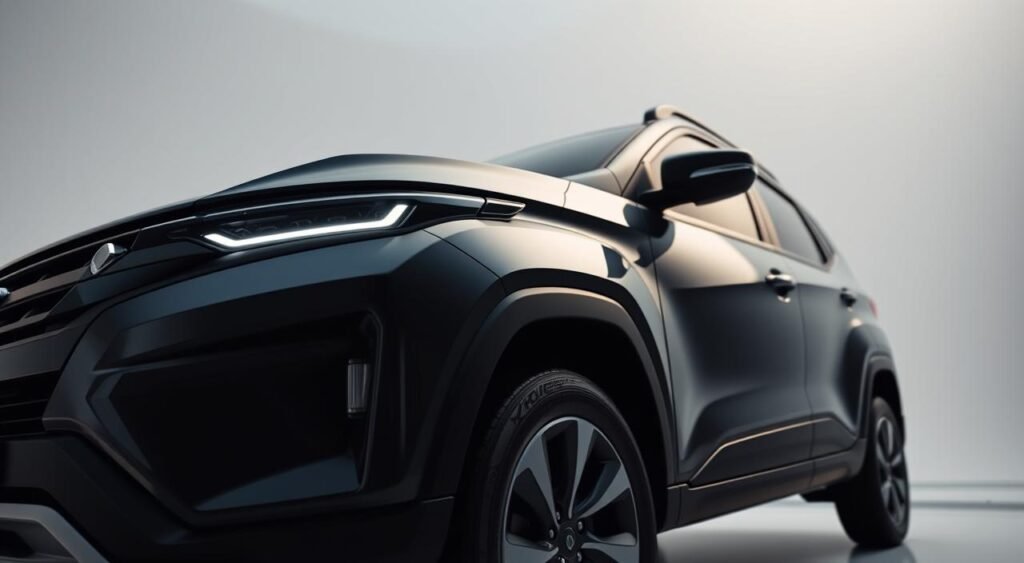
It has three engine options. The 1.5-liter petrol engine has mild-hybrid tech for better fuel use. There’s also a strong hybrid and a CNG option for those who want to save money.
Pricing and Availability Timelines
The Maruti Escudo launches on September 3, 2025, starting at Rs 9.7 lakh (ex-showroom). It’s priced well between the Brezza and Grand Vitara. It will be sold through Arena dealerships across India.
Bookings start in late August 2025. Deliveries will begin right after the launch. Thanks to Maruti’s production and dealer network, there won’t be long waits.
Spotlight on Volvo EX30
The Volvo EX30 is a standout in September 2025 car launches. It’s Volvo’s most compact electric vehicle. This car brings premium electric mobility to a new market.
It’s expected to hit dealerships by late September. The price is around Rs 50 lakh. The EX30 is a gateway to Volvo’s electric future.
Unique Selling Propositions of the EX30
The Volvo EX30 showcases Scandinavian design in the compact electric segment. Its exterior features Thor hammer-shaped LED daytime running lights. This makes it instantly recognizable.
The car has 19-inch aerodynamic alloy wheels. These wheels boost efficiency and look great. L-shaped LED tail lights add to its modern look.
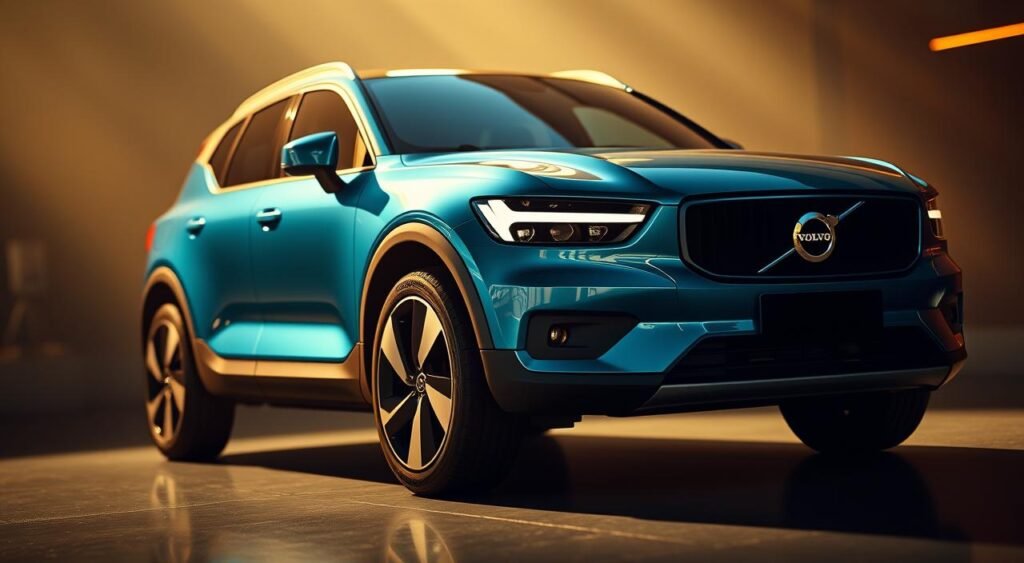
Inside, the EX30 is all about minimalism. It has a 12.3-inch central touchscreen for controlling most functions. It also has:
- Fixed panoramic glass roof for an airy feel
- Dual-zone climate control for comfort
- Wireless charging for devices
- Single 69 kWh battery pack
- Rear-wheel drive system with 272 PS motor
- WLTP-certified range of 480 kilometers
Safety Innovations in Volvo Vehicles
Volvo is known for its safety, and the EX30 is no exception. It comes with seven airbags for protection. A 360-degree camera system offers full visibility.
Advanced Driver Assistance Systems (ADAS) help prevent collisions. These features show Volvo’s dedication to safety in electric vehicles.
Other Notable Car Launches
September 2025 is packed with exciting new car releases in India. These models offer different prices and features for various buyers. From electric to traditional cars, the latest trends and preferences are on display.
Overview of Additional Brands and Models
VinFast brings two electric SUVs to India on September 6. The VF6 starts at Rs 25 lakh with a 59.6 kWh battery for 410 km range. It comes in two variants and six colors, aiming at the premium electric market.
The VF7 launches at Rs 50 lakh with a 70.8 kWh battery for 496 km range. It has eight airbags and a 12.9-inch touchscreen in three variants.
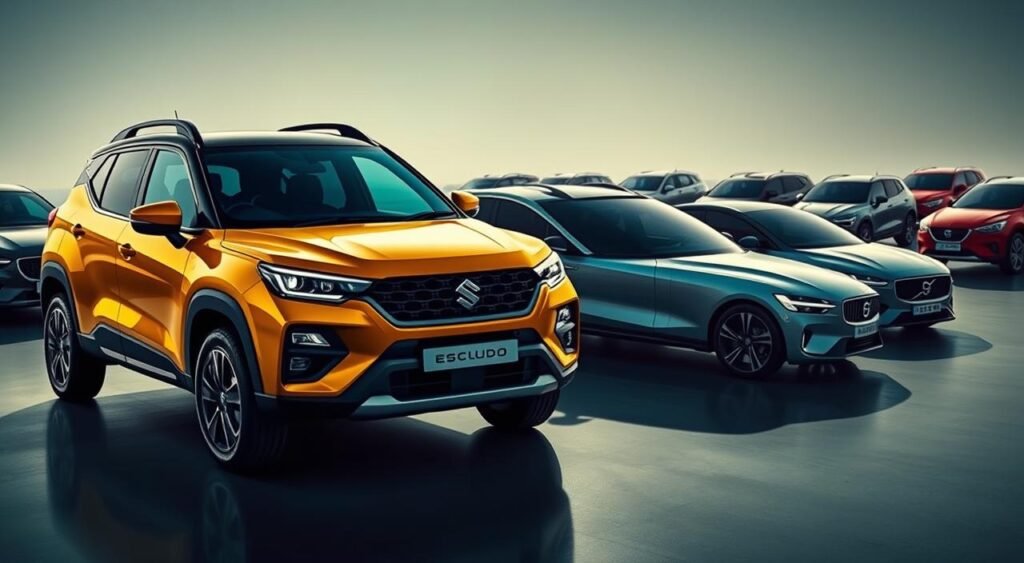
Citroen introduces the Basalt X on September 5 at Rs 14.13 lakh. It has a black finish, ambient lighting, and a 10.2-inch touchscreen. It offers two engine options.
The Mahindra Thar facelift arrives late September at Rs 12 lakh. It features circular LED headlights and a 10.25-inch touchscreen with a digital driver display.
Market Impact and Anticipated Trends
These new releases mark significant changes in India’s car market. VinFast’s electric vehicles add to the EV competition. Citroen and Mahindra focus on upgrading popular models.
The prices range from Rs 12 lakh to Rs 50 lakh. This shows manufacturers are aiming at various segments.
| Model | Starting Price | Key Feature | Launch Date |
|---|---|---|---|
| VinFast VF6 | Rs 25 lakh | 410 km electric range | September 6 |
| VinFast VF7 | Rs 50 lakh | 496 km electric range | September 6 |
| Citroen Basalt X | Rs 14.13 lakh | Black edition styling | September 5 |
| Mahindra Thar | Rs 12 lakh | LED headlights upgrade | Late September |
These updates show a focus on both electric and traditional cars. The variety in options ensures there’s something for everyone in September 2025.
Industry Reactions and Expert Reviews
The car world is buzzing with the 2025 lineup. VinFast is making waves in India with the VF6 and VF7. Their move to Tamil Nadu shows they’re serious about making cars locally.
Initial Impressions from Automotive Experts
Top car critics are talking about Maruti’s new SUV. It fills a gap between the Brezza and Grand Vitara. The Mahindra Thar facelift is also getting attention, coming four years after its debut.
Volvo EX30 is seen as a great deal in the Rs 40-42 lakh range. It makes electric luxury cars more affordable for Indians.
Consumer Anticipations and Feedback
People are excited about the new cars. Citroen’s Basalt X bookings started at Rs 11,000, showing strong interest. Social media is full of:
- VinFast’s EV prices
- Mahindra Thar’s updates
- Maruti’s SUV options
- Volvo EX30’s value
| Brand | Model | Consumer Interest Level | Key Attraction |
|---|---|---|---|
| VinFast | VF6/VF7 | High | New EV technology |
| Maruti | New SUV | Very High | Segment positioning |
| Mahindra | Thar Facelift | High | Design refresh |
| Volvo | EX30 | Moderate | Premium EV value |
Environmental Considerations in New Models
The car industry is getting greener, thanks to new car news in September 2025. Companies are making cleaner cars to fight climate change. This month, they show they care about the planet with new, eco-friendly ways.
How Brands Address Sustainability in 2025
Big car makers are going green in their own ways. VinFast is a leader with its factory in Tamil Nadu. It cuts down on carbon by making cars closer to where they’re sold.
Maruti is also making a big push with the Escudo. It offers:
- Mild-hybrid tech for better gas use
- Strong hybrid to cut emissions by up to 40%
- CNG option for cleaner burning
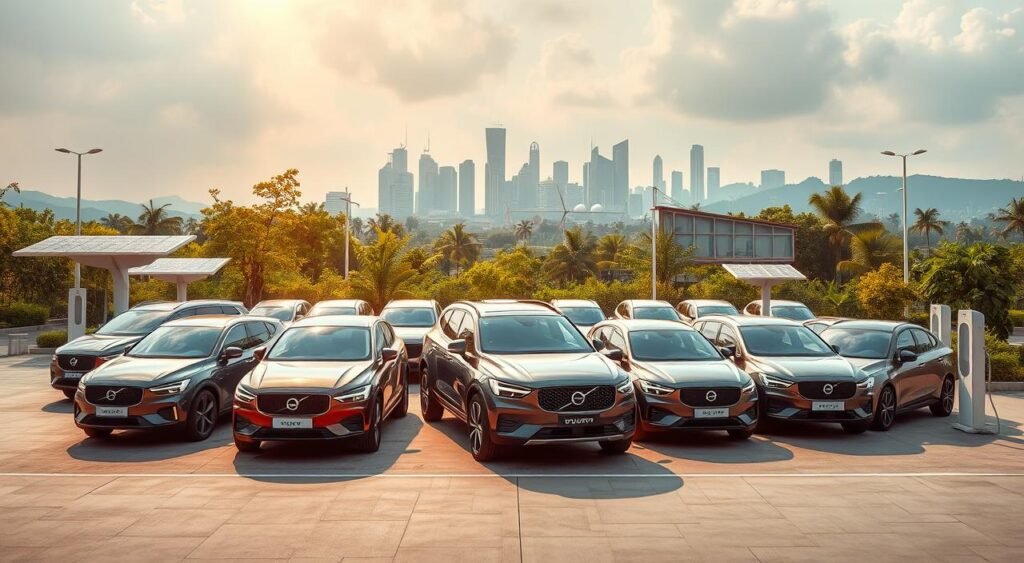
Electric and Hybrid Options Available
New cars are getting a big boost from electric power. Three electric cars lead the charge in September:
| Model | Range (km) | Charging Time |
|---|---|---|
| VinFast VF6 | 410 | 27 minutes (10-70%) |
| Volvo EX30 | 480 | 26 minutes (10-80%) |
| VinFast VF7 | 496 | 31 minutes (10-70%) |
These cars can go far on a single charge. They charge up fast, so you don’t wait long. There are also hybrid and CNG options for those who want to help the planet but aren’t ready for electric.
Conclusion and Future Expectations
The September 2025 car launches are a big deal for the Indian car market. Prices range from Rs 9.7 lakh for the Maruti Escudo to Rs 50 lakh for premium cars. This shows makers are trying to meet every customer’s needs during the festive season.
The Future of the Auto Industry Beyond September 2025
VinFast is coming to India, bringing electric cars to the market. Their prices might make more people choose electric cars in big cities. Mahindra and Maruti are also changing their SUVs to fit what people want now.
This change shows the car world is moving towards green cars but keeping prices low. Volvo and others are making electric cars more affordable. This means customers have more choices, even as rules get stricter on pollution.
Final Thoughts on This Month’s Exciting Launches
September 2025 car launches show the Indian car world is ready to change and grow. Each car meets different needs, from city driving to off-road adventures. These new cars will raise the bar for quality, tech, and value in the future.
FAQ
What are the major car debuts expected in September 2025?
September 2025 will see six big car launches. Maruti Suzuki’s new SUV hits the market on September 3. VinFast VF6 and VF7 electric models debut on September 6. Citroen Basalt X is set for September 5. The Mahindra Thar facelift and Volvo EX30 are expected by the end of the month.
What is the price range for the new car releases in September 2025?
The new cars will range from Rs 9.7 lakh to Rs 50 lakh. This covers a wide range of budgets, making something for everyone.
Which electric vehicles are launching in September 2025?
Three electric cars are launching. VinFast VF6 and VF7 offer ranges of 410 km and 496 km. The Volvo EX30 boasts a 480 km WLTP-claimed range, pushing for green mobility.
What are the key features of the Maruti Escudo?
The Maruti Escudo has a panoramic sunroof and ventilated front seats. It also comes with six airbags, a 360-degree camera, and possibly ADAS. It offers mild-hybrid, strong hybrid, and CNG options.
When can customers book the latest car models launching in September?
Citroen Basalt X bookings are open at Rs 11,000. Other brands will announce booking dates closer to their launch in September.
What safety features are included in the Volvo EX30?
The Volvo EX30 has seven airbags and a 360-degree camera system. It also includes Advanced Driver Assistance Systems (ADAS), ensuring top safety.
Which car news September 2025 relates to local manufacturing?
VinFast’s VF6 and VF7 will be made in Tamil Nadu. This shows VinFast’s commitment to local production in India, cutting down on carbon footprint.
What are the expected automotive industry updates regarding the Mahindra Thar?
The updated Mahindra Thar is expected by end-September at Rs 12 lakh. It features Roxx-inspired design and tech like circular LED headlights and a 10.25-inch touchscreen. It keeps its petrol-diesel engines and offers RWD and 4WD options.
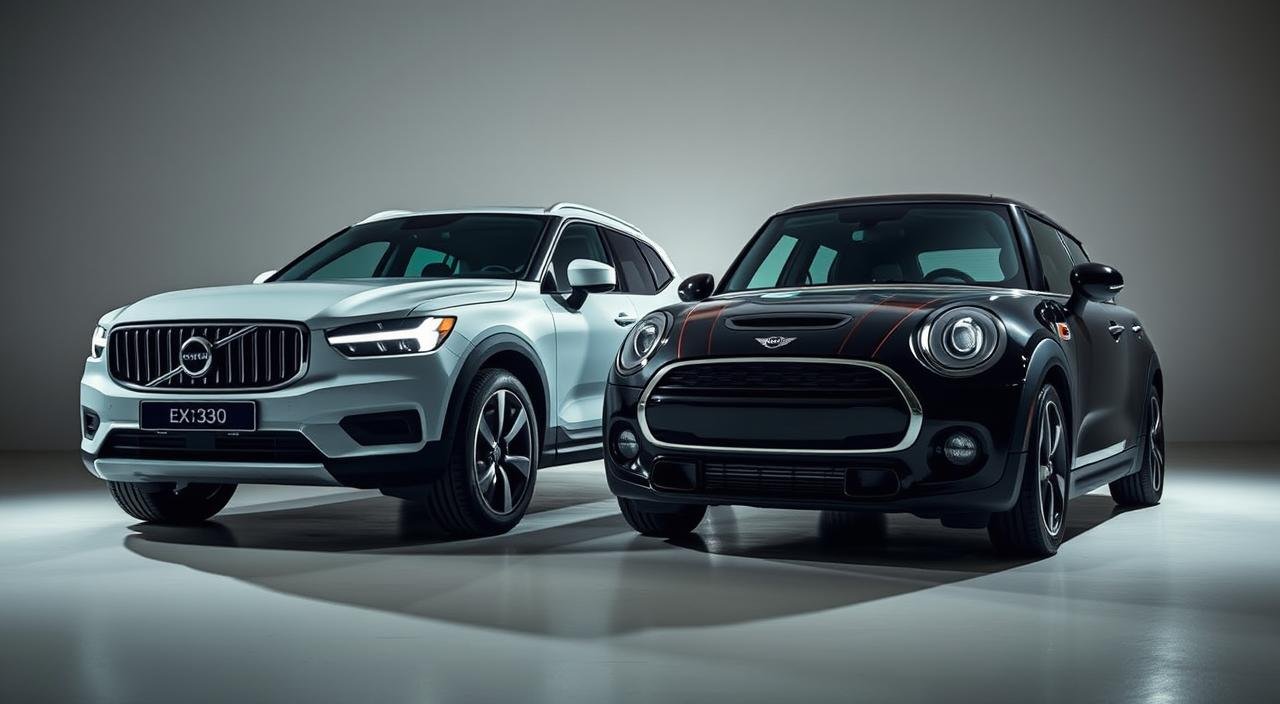
Aug
Can two electric vehicles from opposite design philosophies satisfy the same premium buyer in India’s evolving EV market?
The Indian electric vehicle landscape welcomes two distinct competitors in the premium entry-level segment. Volvo prepares to launch the EX30 as its most accessible electric crossover in the coming weeks. Mini counters with an updated Cooper SE that maintains its iconic hot hatch character while embracing electric power.
This EV comparison reveals contrasting approaches to premium electric mobility. The Volvo EX30 targets practical buyers seeking crossover versatility at an expected Rs 50 lakh starting price. The Mini Cooper SE appeals to driving enthusiasts willing to pay Rs 55 lakh for sporty electric performance in a compact package.
Both premium entry EVs represent strategic moves by established brands to capture India’s growing electric vehicle market. Volvo extends its sustainability commitment with the EX30’s modern design language and crossover positioning. Mini transforms its beloved Cooper into an electric performer without sacrificing its go-kart driving dynamics.
The price difference of Rs 5 lakh between these models reflects their distinct market positions. Buyers must choose between the EX30’s practical space and the Cooper SE’s performance-focused approach. Each vehicle offers unique advantages that define what premium entry EVs can deliver in today’s market.
Key Takeaways
- Volvo EX30 starts at Rs 50 lakh while Mini Cooper SE begins at Rs 55 lakh
- EX30 offers crossover practicality versus Cooper SE’s hot hatch performance
- Both models target premium buyers entering the electric vehicle segment
- Volvo launches in coming weeks with modern design and sustainability focus
- Mini maintains iconic styling while adding electric powertrain technology
- Price gap reflects different approaches to premium electric mobility
- Choice depends on buyer preference for space versus driving dynamics
Overview of Premium Entry EVs
The car world is changing fast. Now, we see more affordable electric cars that are fancy but not too pricey. These cars offer cool tech and luxury without the high cost of top models. They make electric cars more available to more people, keeping quality high.
What Are Premium Entry EVs?
Premium entry electric cars sit between regular and luxury cars. They have fancy features like leather seats and smart tech for about $30,000 to $45,000. They focus on design and driving fun, but are priced for more people.
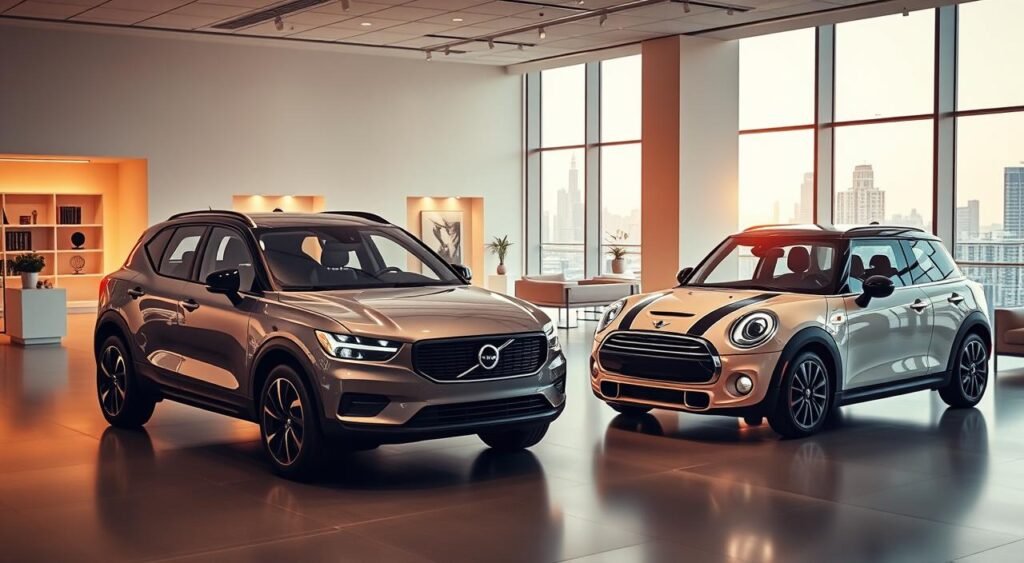
Popularity and Market Trends
Sales of these cars are skyrocketing. Makers are pricing them well and giving great lease deals. This makes electric cars more attractive to many buyers. In India, more charging spots and government help are boosting electric car sales, with these models leading the way.
Key Features of Modern Electric Vehicles
Today’s affordable electric cars have features usually found in luxury cars:
- Range capabilities between 200-300 miles per charge
- Fast-charging support reaching 80% in under 30 minutes
- Connected services with smartphone integration
- Sustainable interior materials including recycled plastics
- Advanced safety systems earning top crash test ratings
These cars are also good for the wallet, with efficiency ratings of 3.4-4.0 miles per kWh. They’re great for daily drives and weekend trips.
Design and Aesthetics
The look of electric cars is key in drawing in customers. The Volvo EX30 and Mini Cooper SE show off different styles. These styles reflect their brand’s history and modern electric car trends. They bring new looks to the electric car market.
Exterior Design Comparisons
The Volvo EX30 is longer than the Mini Cooper SE. It’s 14.8 inches longer, giving it a stronger look on the road. The EX30 is also wider and taller, making it look more solid compared to the Mini.
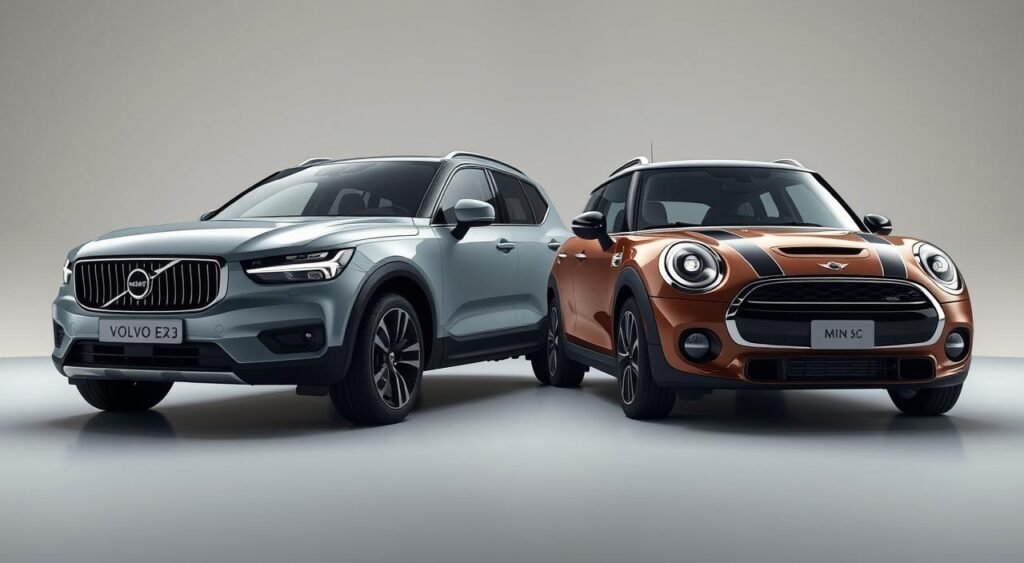
The EX30 has a longer wheelbase than the Mini. This means more room inside and a smoother ride. The Volvo has 19-inch wheels, while the Mini has 17-inch wheels. This affects how they look and handle.
Interior Comfort and Materials
Inside, both cars have a simple design. They don’t have traditional gauges. Instead, they use digital screens for a clean look. The EX30 has more room for your head and legs.
The Volvo has a fixed panoramic roof, adding natural light. This makes the car feel bigger and more comfortable on long trips. Both cars use eco-friendly materials in their interiors, pleasing those who care about the planet.
Color Options and Customization
Customizing your car is important for many buyers. Each brand has its own color choices:
| Feature | Volvo EX30 | Mini Cooper SE |
|---|---|---|
| Exterior Colors | 5 options including Cloud Blue | 8 options including British Racing Green |
| Interior Themes | 4 sustainable material combinations | 3 traditional and vegan options |
| Wheel Designs | 2 styles in 19-inch | 3 styles in 17-18 inch |
| Roof Options | Fixed panoramic glass | Standard or contrast color |
Mini Cooper and Volvo take different paths in customization. Mini offers more colors, keeping its fun vibe. Volvo goes for elegant, eco-friendly options, appealing to those who value refined simplicity.
Performance and Driving Experience
Performance is key when choosing a premium electric car. The Volvo EX30 and Mini Cooper SE offer different electric driving experiences. They cater to various tastes and needs in India.
Acceleration and Speed
The Volvo EX30 is fast, thanks to its rear-wheel-drive setup. It has a 272PS electric motor and 343Nm of torque. It goes from 0-100 kmph in just 5.3 seconds, making it one of the fastest in its class.
The Mini Cooper SE has a 184PS electric motor. While exact acceleration figures for India aren’t confirmed, it’s fast and true to Mini’s sporty vibe.
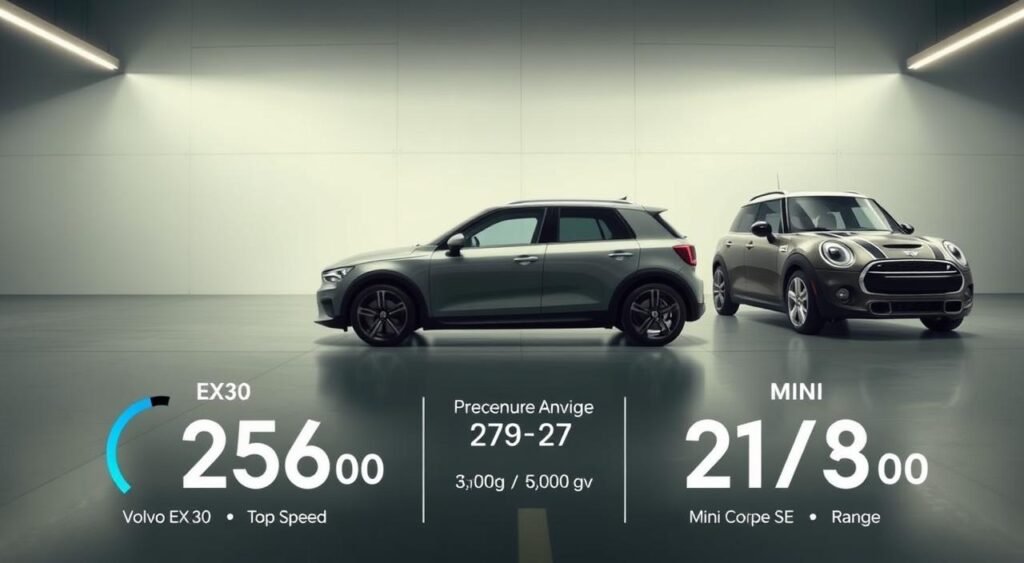
Handling and Ride Quality
Both cars are great in cities, but they handle differently. The EX30 has balanced dynamics, while the Mini Cooper SE has the brand’s signature go-kart feel. Their small size makes them perfect for India’s busy streets.
Battery Range and Charging Times
The Volvo EX30 has a big advantage in range. Its 69kWh battery pack offers up to 480km WLTP-claimed range. The Mini Cooper SE has a 36.6kWh battery, good for about 298km. The EX30’s longer range is better for longer trips in India.
Technology and Infotainment
The digital experience inside premium electric vehicles is key to daily driving. The Volvo EX30 and Mini Cooper SE offer impressive tech features. These features make the cabin a connected hub, keeping drivers and passengers entertained.
Dashboard Layout and Usability
The Volvo vs Mini EVs comparison shows different interior designs. The EX30 has a single 12.3-inch touchscreen for all controls. This design makes the interior look clean and simple.
The Mini Cooper SE also has a modern design. It features a 9.45-inch circular display. This keeps the brand’s iconic look while using the latest tech.
Connectivity Features
Both vehicles are great at keeping drivers connected. They come with:
- Wireless Apple CarPlay and Android Auto
- Wireless phone charging pads
- Connected car technology with smartphone apps
- Multiple USB-C ports for device charging
The EX30’s larger screen is perfect for navigation and media. The Cooper SE has a heads-up display for important info on the windshield. The EX30 has a 9-speaker Harman Kardon system, while the Cooper SE has its own multi-speaker setup.
Safety Technology and Ratings
Safety is a top priority in these electric vehicles. Both models have advanced safety features. They include multiple airbags, 360-degree cameras, and driver assistance systems.
They also have electronic parking brakes and tire pressure monitoring. The EX30 has dual-zone automatic climate control for comfort. The Cooper SE has customizable interior lighting for ambiance.
Cost and Value Analysis
When you buy an entry-level electric car, it’s not just about the price. The Volvo EX30 and Mini Cooper SE show two different ways to enjoy electric driving in India. Each car has its own special features that attract different buyers.
Pricing Breakdown of Both Models
The Volvo EX30 starts at Rs 50 lakh, making it cheaper than the Mini Cooper SE. The Mini Cooper SE costs Rs 55 lakh. This price difference shows the Mini’s value in its brand and design.
| Model | Expected Price (Ex-showroom) | Battery Capacity | Range (WLTP) | Power Output |
|---|---|---|---|---|
| Volvo EX30 | Rs 50 lakh | 69 kWh | 480 km | 272 PS |
| Mini Cooper SE | Rs 55 lakh | 36.6 kWh | 298 km | 184 PS |
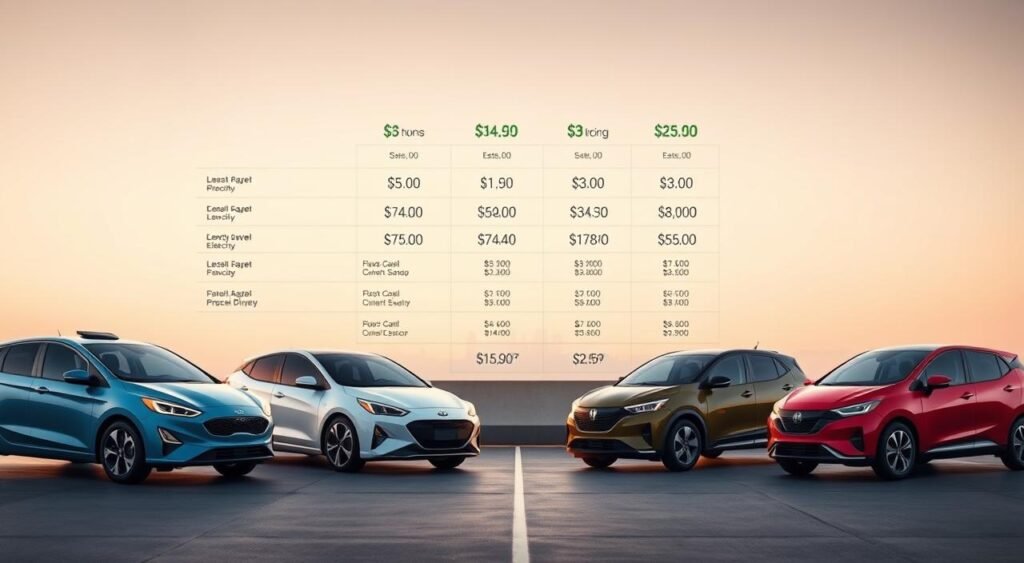
Incentives and Rebates
Indian buyers can get help from state EV incentives. These incentives lower the cost of these electric cars. You can also get tax breaks and lower fees for electric vehicles.
Ownership Costs and Resale Value
The Volvo EX30 has a bigger battery, meaning you charge it less often. It also keeps its range longer than the Mini Cooper SE. Electric cars need less maintenance, saving you money. The EX30 might hold its value better in India’s growing used EV market.
Sustainability and Environmental Impact
When looking at premium electric vehicles, the environment matters a lot. The Volvo EX30 and Mini Cooper SE are big steps toward green travel. They have no tailpipe emissions and cut down on carbon compared to gas cars.
Materials Used in Manufacturing
Electric car makers focus on green materials. Volvo uses recycled plastics and eco-friendly materials in the EX30’s interior. Mini does the same with the Cooper SE, using recycled aluminum and sustainable fabrics for seats.

Energy Consumption Comparison
How efficient electric cars are varies a lot. The Volvo EX30 gets 3.4-3.7 miles per kilowatt-hour. Here’s how it stacks up against others:
| Electric Vehicle Model | Efficiency (m/kWh) |
|---|---|
| Tesla Model 3 | 4.4-5.0 |
| Renault 5 E-Tech | 4.1-4.3 |
| Kia EV3 | 4.0-4.2 |
| Volvo EX30 | 3.4-3.7 |
Long-term Environmental Benefits
Electric cars are better for the planet over time. They cut down on carbon emissions when powered by clean energy. They also improve city air quality by not producing local emissions.
These cars also reduce noise pollution and fossil fuel use. This makes them great for those who care about the environment in India’s growing EV market.
Conclusion and Recommendations
The Volvo EX30 vs Mini Cooper SE shows two different ways to make premium entry EVs. Each car has its own strengths in the electric car world. The EX30 has a big cabin and a large battery. The Cooper SE is small and great for city driving.
Both cars show how electric cars are getting more affordable in India.
Which Model is Right for You?
The Volvo EX30 is perfect for those who need room and range. It’s big, so it’s comfy for families and long trips. Its battery lasts longer, making it easy to drive on highways.
The Mini Cooper SE is ideal for city drivers who want to be quick. It’s small, so it’s easy to park. It looks cool and has a rich brand history.
Final Thoughts on Volvo EX30 and Mini Cooper SE
The Volvo Mini Cooper comparison highlights their different focuses. The EX30 has a big roof and screen for more comfort. The Cooper SE has a display for the driver to stay focused.
The EX30 is cheaper, which is good for those watching their budget. The Cooper SE is for those who love the Mini brand. Prices and details for India will help you decide.
The Future of Entry-Level Premium EVs
Premium entry EVs like these are a sign of good things to come. They’re high-quality and affordable. New tech means better batteries and faster charging.
As India’s electric car market grows, we’ll see more choices. This competition makes both brands offer better deals. You win with more features and lower prices.
FAQ
What is the price difference between the Volvo EX30 and Mini Cooper SE in India?
The Volvo EX30 starts at around Rs 50 lakh. This is about Rs 5 lakh less than the Mini Cooper SE, which is expected to cost Rs 55 lakh. Both cars fall under the Rs 60 lakh category in the premium electric vehicle market.
Which EV offers better range – Volvo EX30 or Mini Cooper SE?
The Volvo EX30 has a much longer range than the Mini Cooper SE. It can go up to 480km on a single charge, thanks to its 69kWh battery. In contrast, the Cooper SE can travel about 298km with its 36.6kWh battery. So, the EX30 is better for long trips.
How do the dimensions compare between these two electric vehicles?
The Volvo EX30 is bigger than the Mini Cooper SE. It’s 375mm longer, 82mm wider, and 90mm taller. It also has a longer wheelbase, which means more room inside and better headroom.
What are the performance specifications of both EVs?
The Volvo EX30 has a rear-wheel-drive setup with a 272PS electric motor. It can go from 0-100 kmph in just 5.3 seconds. The Mini Cooper SE has a 184PS motor, but the EX30 is faster.
Which entry-level electric car offers better technology features?
Both cars have modern tech, but with different perks. The EX30 has a bigger 12.3-inch touchscreen and a 9-speaker Harman Kardon audio system. The Cooper SE has a 9.45-inch screen and a heads-up display, but no Harman Kardon system. Both support Android Auto, Apple CarPlay, and connected car tech.
Are these premium electric vehicles good value compared to petrol alternatives?
Yes, electric vehicles in this segment are now competitive with petrol cars. With better deals and discounts, electric cars are becoming more appealing. The Volvo EX30 stands out with its larger battery, longer range, and stronger performance.
What is the energy efficiency of these best electric vehicles?
The Volvo EX30 has an efficiency rating of 3.4-3.7 m/kWh. This is good but not the best. The Tesla Model 3 and Renault 5 E-Tech are more efficient. Both EX30 and Cooper SE reduce air pollution in cities.
Which premium EV is better for city driving versus highway use?
The Mini Cooper SE is great for city driving due to its small size and easy handling. The Volvo EX30 is better for long trips. It has a longer range and a bigger battery, making it suitable for highways and longer drives.
